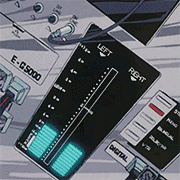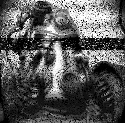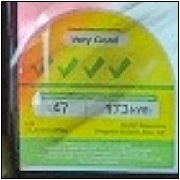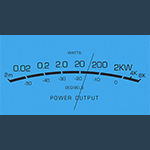|
Khablam posted:That's the later model. It's specifically the first model the audiophools get excited about, the one with the grey tiles. I'm pretty sure it was still an SCPH-1001. Who knows though, it's been 20 years 
|
|
|
|

|
| # ? May 18, 2024 18:42 |
|
Courtesy of the Better Call Saul thread...quote:but vinyl can accomplish things regular redbook audio cannot. quote:Please! Please tell me what! quote:There's no loudness ceiling, for one thing. Digital music can only be so loud, but true analogue doesn't really have that limitation.
|
|
|
|
https://www.youtube.com/watch?v=wi_aawsChqA
|
|
|
|
Combat Pretzel posted:Courtesy of the Better Call Saul thread... 
|
|
|
|
Just tell whatever twit said that, that he's right* but it comes at the expense of low volume, since Vinyl DR is provably no better than 120db, whilst CD is 150db. Watching them try to twist it around to why that's 'better' is fun. * - I mean he's not, because it's relative, but it's more fun that way.
|
|
|
|
Khablam posted:Just tell whatever twit said that, that he's right* but it comes at the expense of low volume, since Vinyl DR is provably no better than 120db, whilst CD is 150db. ~70dB and ~115dB, rather.
|
|
|
|
Combat Pretzel posted:Courtesy of the Better Call Saul thread... It's true, clipping didn't exist before digital audio.
|
|
|
|
Could God's band record an album so loud even His stereo could not play it?
|
|
|
|
Waldo P Barnstormer posted:Could God's band record an album so loud even His stereo could not play it? 
|
|
|
|
KozmoNaut posted:~70dB and ~115dB, rather. Where do these come from? I was applying what I knew to be the theoretical limits of the mediums, rather than real world testing, as that's what audiophiles will claim their setup gets. But perhaps I am off.
|
|
|
|
Khablam posted:Where do these come from? I was applying what I knew to be the theoretical limits of the mediums, rather than real world testing, as that's what audiophiles will claim their setup gets. But perhaps I am off. If going by the strictest definition, the dynamic range of CD-quality audio is ~96dB (~6dB per bit). This is based on unweighted calculation of the dynamic range afforded by 16-bit audio. With dithering and noise shaping based on the sensitivity curve of human hearing, a weighted (or perceived) ~115dB can be achieved, which is roughly equivalent to an effective 20 bits of dynamic range. In turn, this is close to the dynamic range limit of analog electronics, which is equivalent to around 21-22 bits in the very best equipment, limited by thermal self-noise (Johnson noise) inherent to all analog electronic circuits. To hit ~150dB, you would need 24-bit audio (~144dB). The comparison with LPs isn't completely straightforward. When you hit the limits of a digital format, you hit them hard, but with analog formats, you get a bit of leeway where the sound will start to compress as you push the limits. This is especially true of analog tape where the built-in compression and soft limiting of overdriven signals has been used as an effect in studios, particularly for drums. Recording the drum tracks into reel-to-reel tape slightly "hot" and then re-digitizing them takes the "edge" off the sound, and gives it a nice vintage-style analog warmth. Most people probably just do that with a set of digital effects these days, but it used to be a common trick for drum tracks. I was actually a little optimistic when stating the dynamic range of LPs, ~60dB seems to be the generally accepted limit, for a brand-new LP on a good turntable with a good cartridge and brand-new stylus. That's roughly equivalent to 10 bits in the digital world. Maybe ~70dB is possible under absolutely perfect conditions, which is still less than 12 bits equivalent. Good first-generation reel-to-reel tape can reach maybe ~80dB or so (a little higher than 13 bits), but of course this goes way down with successive playback and second/third/fourth-generation copies, as with all analog media.
|
|
|
|
Is there an additional amount of range available when using a brand new record in one of those laser turntables?
|
|
|
|
fishmech posted:Is there an additional amount of range available when using a brand new record in one of those laser turntables? No, and they actually suck. Since there is no physical contact with the record, it has to be absolutely 100% spotless, because any little bit of dust will be amplified as if it was part of the groove. There is some built-in click and noise reduction, but the results are unspectacular at best. https://www.youtube.com/watch?v=S7qcTNVnggg
|
|
|
|
Wow, that sounds like poo poo.
|
|
|
|
Collateral Damage posted:Wow, that sounds like poo poo. It's a vinyl LP, what did you expect?
|
|
|
|
Combat Pretzel posted:Courtesy of the Better Call Saul thread... I think that what he's trying to say is that for a while (maybe even today), the studios clipped the hell out of CDs trying to make them sound "louder", which more-than-negated the dynamic range benefits of the CD over vinyl (where they didn't try to pull that poo poo).
|
|
|
|
KozmoNaut posted:If going by the strictest definition, the dynamic range of CD-quality audio is ~96dB (~6dB per bit). This is based on unweighted calculation of the dynamic range afforded by 16-bit audio. With dithering and noise shaping based on the sensitivity curve of human hearing, a weighted (or perceived) ~115dB can be achieved, which is roughly equivalent to an effective 20 bits of dynamic range. In turn, this is close to the dynamic range limit of analog electronics, which is equivalent to around 21-22 bits in the very best equipment, limited by thermal self-noise (Johnson noise) inherent to all analog electronic circuits. I always look forward to reading your posts in here because I inevitably learn something cool. That said, vinyl is better than mp3's because it is immune to signal degradation caused by cosmic rays.
|
|
|
|
Waldo P Barnstormer posted:I always look forward to reading your posts in here because I inevitably learn something cool. That's why ECC is built into chips. Besides when cosmic rays give you a flipped bit or two in main memory, MP3 quality will be least of your worries when they are going to loving crash your computer outright.
|
|
|
|
Palladium posted:That's why ECC is built into chips. Okay, so why do you think they sent a golden record into space on Voyager then, smart guy?
|
|
|
|
Zemyla posted:I think that what he's trying to say is that for a while (maybe even today), the studios clipped the hell out of CDs trying to make them sound "louder", which more-than-negated the dynamic range benefits of the CD over vinyl (where they didn't try to pull that poo poo). Heavy-handed dynamic range compression actually started on LPs and 45s. There is the built-in compression from using analog tape as the master recording, but hit singles in particular would often be heavily compressed. Phil Spector basically started it in the 1960s with his "Wall of Sound" approach to production. These days, most LPs are cut from the exact same master as the CD, with dynamic range compression, limiting, clipping and all of that crap. The main difference is that the LP format cannot clip in the same way as digital audio. Keeping the cutting stylus locked in place due to a flat-topped waveform will burn out the motors, and for roughly the same reason, the playback stylus won't actually produce sound if it's just moved to a position and kept there, it needs to move back and forth in order to produce an electrical signal. So what happens is that the clipped waveform becomes a sort of downward-facing slope, similar to a high-pass filtered square wave, which is more or less what it actually is. Some people seem to think this makes the clipping sound less harsh, but it's really just a bad workaround to bad production. Waldo P Barnstormer posted:I always look forward to reading your posts in here because I inevitably learn something cool. Aww shucks. I guess my anti-audiophile skills can come in useful once in a while 
|
|
|
|
Someone's going to make this for real, aren't they? https://www.youtube.com/watch?v=w5HT7b1ZG1c
|
|
|
|
120dB of dynamic range is enough to distinguish a mosquito in front of a jet taking off
|
|
|
|
qirex posted:Someone's going to make this for real, aren't they? I thought this was a Cinco brand infomercial at first. https://www.youtube.com/watch?v=ZG8ZKwaC1jY
|
|
|
|
This may be too broad a question, but do garden-variety mechanical volume controls (potentiomenters I guess, in the case of consumer audio gear) have a "unity gain" point? I would think that would be at full clockwise but I guess that could also be affected by preamp design.
|
|
|
|
Panty Saluter posted:This may be too broad a question, but do garden-variety mechanical volume controls (potentiomenters I guess, in the case of consumer audio gear) have a "unity gain" point? I would think that would be at full clockwise but I guess that could also be affected by preamp design. You rang?
|
|
|
|
Here is a new one on me, a liquid audio cable from Teo Audio. A review of them contained gems such as: quote:The three men of Teo Audio -- Ken Hotte, Taras Kowalczyszyn and Brian Kurtz -- believe theirs is the first commercial audio cable in the world where electromagnetic propagation steers its own pathway through a fluid conductor which responds to the applied current in real time. quote:Ken Hotte provided this brief glimpse into his perspective: "As the drive current levels (amperage-current/electron mass) change in different audio systems, the response of this cable will change as the fluid is a free-floating molecular slurry and the individual molecules have the opportunity to directly react to the change in current mass. i.e. the current mass steers the fluid into specific alignments. Dynamically, in real time." Not content to stop there, they have a passive preamplifier with only an input select and volume know using their liquid cables throughout, no transformers or anything. You can even change the foot on the bottom center of it to change how it sounds, according to them. Somehow this unit will passively do something by being full of liquid metal somehow. I honestly cannot parse any of their statements. I've never noticed a problem with copper, and it seems to my uninformed mind that a cable of liquid metal actively reacting to an electrical signal going through it seems like nonsense and like it would be more harmful to the signal than beneficial.
|
|
|
|
Unity Gain posted:You rang? I did, I assume you know the unity gain point of all devices 
|
|
|
|
Panty Saluter posted:This may be too broad a question, but do garden-variety mechanical volume controls (potentiomenters I guess, in the case of consumer audio gear) have a "unity gain" point? I would think that would be at full clockwise but I guess that could also be affected by preamp design. Depends what the volume knob is made from. evilcat describes the most simple preamp: evilcat posted:a passive preamplifier with only an input select and volume knob In which the volume knob is a potentiometer with zero resistance at max volume and infinite resistance at zero volume. In the case of an active pre-amp, it would vary from device to device and you would really have to measure it to find our friend Unity Gain. evilcat posted:I've never noticed a problem with copper, and it seems to my uninformed mind that a cable of liquid metal actively reacting to an electrical signal going through it seems like nonsense and like it would be more harmful to the signal than beneficial. It's a good system because if you turn it on it's side everything stop working because all the fluid flows to one end.
|
|
|
|
Well I was wondering about a consumer receiver so it's most likely an active preamp. Although if it is it's very slow, it barely tickles -30 on my power amp (the meters are input level). Maybe these stupid silver plated interconnects are limiting current since they're tarnished  (I got them for free, don't hassle me) (I got them for free, don't hassle me)
|
|
|
|
evilcat posted:Here is a new one on me, a liquid audio cable from Teo Audio. I enjoy how they describe the cable as containing slurry which is a word associated mostly with liquid poo poo. Mostly from bovines, so in effect, their cables contain bullshit. Apt I feel.
|
|
|
|
 crosspostin'
|
|
|
|
Panty Saluter posted:
That looks unsettling and I'm genuinely a little creeped out by that picture.
|
|
|
|
The sense of scale in that picture is all weird and it looks like the cable is a foot thick.
|
|
|
|
Collateral Damage posted:The sense of scale in that picture is all weird and it looks like the cable is a foot thick.
|
|
|
|
I wanna know what that boxy looking thing bottom right is supposed to be. It has no cables and appears to have nothing inside it. I wonder how that's affecting the sound.... 
|
|
|
|
88h88 posted:I wanna know what that boxy looking thing bottom right is supposed to be. It has no cables and appears to have nothing inside it. I wonder how that's affecting the sound....
|
|
|
|
It's just the cover for the valve amp  But quantum cryolated!
|
|
|
|
Who wanna bet that the equipment PCBs have lovely soldering jobs that audiophiles somehow don't care about?
|
|
|
|
Getting back to "liquid cables" for a moment, I noticed this on TEO's site: http://www.teoaudio.com/products/liquid-preamplifier/ quote:Transformers are not necessary in this unit because it employs Liquid Cable technology throughout, which effects perfect impedance matching between source and amplifier, First, I didn't think unbalanced connections were matching impedance, and second...are they using liquid mercury or something as a conductor? how does that make transformers unnecessary? 
|
|
|
|

|
| # ? May 18, 2024 18:42 |
|
Collateral Damage posted:The sense of scale in that picture is all weird and it looks like the cable is a foot thick. That's because it pretty much is a foot thick, or close to it.
|
|
|





























